
|
During the Great Depression, the New Alberene Stone Company was forced to close. Earl Sr. then found work across Afton Mountain in Waynesboro, Virginia, as a machinist at a DuPont factory, some 33 tortuous highway miles away. He stayed in a boarding house in Waynesboro through the week and every weekend took the bus to Charlottesville and then transferred to another bus which took him to Hickory Creek, and then a six-mile walk on home. This six-mile hike on Christmas Eve of 1933 became the inspiration for his son's novel The Homecoming, which was to become the well-loved Christmas television special by the same name. There were to be eight offspring in all including Earl Jr.; the couple completed their family when their third girl, Nancy Alice, was born in 1940.
In
his biography of Hamner, Jim Person describes Earl Sr.:
Even though Earl Sr. had little formal education and Doris hadn't gone beyond high school, they had a reverence for education and encouraged their children to stay in school. Olive Giannini, Earl Jr.'s great aunt, was his sixth-grade teacher and also encouraged his interest in writing and in education. Nevertheless, Earl Jr. had never been more than forty miles away from home until he went with his fellow seniors on a trip to the World's Fair in 1939 in New York City. Earl recalls that the family had never had a telephone and that on the New York trip he had to be shown how to "work" one. That same year young Earl graduated at the top of his class from Schuyler High School.
Earl worked in the summer painting dorms and was a dispatcher for The Brooks Transportation Company during the school year to help pay his expenses.
Hamner
was discharged from the Army in March of 1946 and returned to
Richmond. His Aunt Nora knew he wanted to be a writer, so she
introduced him to Bill Robinson, an editor of the Richmond
News Leader who referred him to local radio station WMBG.
He was hired as an apprentice in the Program Department. For
Earl this led to a lifelong excitement about radio, its power
to come into people's homes, to inform and to entertain. He
was determined to learn more which led him to a special summer
program at Northwestern University. In
June of 1948, Earl Hamner received a Bachelor of Fine Arts degree
with a major in broadcasting from the College of Music of the
University of Cincinnati and was promptly hired full-time by
WLW, Cincinnati's most powerful radio station, where he had
worked part-time while finishing his degree. When he won an
award for script-writing during his first year, a fellow recipient
was Rod Serling, who had attended nearby Antioch College, and
they formed a friendship which ended up lasting a lifetime.
In 1953, on a Friday afternoon, he submitted his first novel Fifty Roads to Town to Random House. The following Monday morning he received a call from editor Belle Becker to say that she had read the book over the weekend and that it had been accepted for publication! On the jacket it was described as "a novel based on the strange folkways of Earl Hamner's own people." When Random House sent him down to an autographing in Richmond, he learned that his Aunt Nora "took to the bed" after reading it, exclaiming "nobody in our family has ever worshiped our Maker by dancing on the piano, and no one in the family, as far as I know, has ever voided on the ground." She was referring to the fact that one scene in the book described an orgiastic religious ceremony. In another, one of the characters, a mentally challenged man, urinated out in the woods. Finally, he was able to persuade her that he was writing about fictional holy-rollers in a fictional Southern village and not about the Hamner family. One
of the radio programs that Hamner wrote for was Biography
in Sound. Because he had become stuck on a stalled subway
train, he was forty minutes late for his interview with Eleanor
Roosevelt for the piece on her "Uncle Teddy." When
he started to apologize, she said, "Please, you gave me
time to catch up on some letters." He suggested that NBC
do a segment on Thomas Wolfe, and they agreed. He was able to
gather many people who had been associated with Wolfe including
Tom's sister, Mabel Wolfe Wheaton. They became good friends,
and she visited him often in New York. In 1956, a son, Scott, was born to the couple, and in 1958, a daughter, Caroline, was born.
The
Hamners rented a house on Fire Island, a popular resort parallel
to Long Island. Earl worked in the city during the week and
then joined his family on Friday on the "Daddy" boat,
and returned to Manhattan on Monday morning That same year, Dial Press published Spencer's Mountain, a novel by Earl Hamner. The title came from his paternal grandmother's family; the story from his own experience growing up in the Blue Ridge Mountains of Virginia. That same year, with two young children in tow, the Hamners made the momentous and gutsy decision to move to Southern California because the center of television production was clearly moving from New York to California. They brought with them dogs, rabbits, guinea pigs, turtles, and a chipmunk. His book, The Avocado Drive Zoo: At Home with My Family and the Creatures We've Loved (1999), describes these first years they were in California. Soon after they moved, Hamner submitted some script ideas to his friend, Rod Serling, and was hired to write for The Twilight Zone. In an interview with Tony Albarella published in Filmfax, Hamner commented, "I was raised on folk songs and folk stories, and I suppose it was inevitable that this kind of material worked its way into my writing. Several times I was able to use folk material in my Twilight Zone episodes, and I thought it courageous of Rod to accept this 'offbeat' kind of storytelling. Looking back, I realize that if I made any unique contribution to the series, it was to introduce the American folklore element into it." Meanwhile,
Warner Bros. had purchased the film rights to Spencer's Mountain.
After the film came out in 1973, starring Henry Fonda and Maureen
O'Hara, Hamner was commissioned to write a film for Warners
called Palm Springs Weekend, and he was well on his way
to a successful Hollywood career. In an interview with Australian
journalist Alex Paige, Hamner noted his astonishment to find
himself a "success" in Hollywood: In 1965, Dial published Hamner's novel, You Can't Get There from Here. The story revolved around a day-long search through the streets of New York for his father by a boy who had spent the summer with his grandparents in Virginia. Composer Richard Rodgers fell in love with the book and optioned it planning to fashion it into a Broadway musical. Earl met with Mr. Rodgers and discussed the project. Sadly, the composer died before finishing the musical.
"I
remember David Selby once when he was starring on Falcon
Crest said, 'Earl, do I really have to say this crap?' And
I said, 'No David, let's make it right for you!' But that was
quite rare. I remember once Michael Learned objected to the
fact that she poured coffee all the time as her character. So
. . . I changed it so the next episode the father was pouring
the coffee. . . . [Once] Ellen Corby came to my office and she
had rewritten a seven-page scene so it was 12 pages long. And
I looked at it and I said, 'Ellen, I'm not going to let you
do this.' So she marched all the Of course, The Waltons has made an indelible impression on television audiences worldwide and deeply impacted Hamner's own family. He told Deborah Rieselman of the University of Cincinnati Magazine that once his brother Jim got a speeding ticket, and the police officer called him "Jim-Bob"! While
working tirelessly on The Waltons series, Hamner continued
to write for film. Two of his best-known achievements were Where
the Lilies Bloom, originally written by Bill and Vera Cleaver,
and Charlotte's Web, which he adapted from the E. B.
White classic. When Hamner was invited to the University of
Cincinnati in 2004 to receive the Frederic Ziv Award for outstanding
achievement in telecommunication, he told his audience: When
The Waltons' run finally ended, Hamner had been working
on two fairly distinct ideas which he combined in the Falcon
Crest series. It was about an Italian family in the vineyard
business, like his mother's people, the Gianninis, but set in
California's Napa Valley. Hamner told Tony Albarella in an interview
for Filmfax: "Falcon Crest may seem a startling change of pace from The Waltons, but in many ways the Gioberti family of Falcon Crest were The Waltons of today. The matriarch of the family, played by Jane Wyman, was proud of her family, and, while she often was underhanded in doing so, she did everything she could to nurture the rituals, history, and customs of her family. She was proud of her land, valued the continuity of it, and I suspect would have gone to any lengths to protect it." After
five of its nine seasons, Earl Hamner quit the series. He told
Paige: "Well, I left at the end of the fifth season. I never even watched it again; I was not pleased with the direction it was going in. I also was not sympathetic to some of the people that were brought aboard. And I was tired, and being in charge with whatever happens on the show, you take the glory and the credit as well, but I had taken that for so long, about fifteen years with both The Waltons and Falcon Crest, so I was very tired, and I didn't feel that I was coping as I might. And also I had become comfortable financially and didn't need to work. Although now, I need to -- not for the money, but to prove to myself and to others in the business that age need not impair one's talent, but on the contrary can contribute the benefit of experience the years have brought and, if we've been lucky, even a small smidgen of wisdom. I think that's been the story of my life on television. To try to tell a story, when networks have always insisted on the element of sex and some violence. And violence is not something that I care for. Sex I do care for."
"Television has the power and the ability to enlighten, to educate, to lift viewers to new levels of experience, but there is also a lot of vulgarity. Too much of what we see seems to be written from the groin. I urge you to write from your heart...." After he left Falcon Crest, Hamner formed a production company with Don Sipes which produced many shows, including Snowy River: The McGregor Saga (1993-1996), The Ponder Heart, based on a novel by Eudora Welty (2001), and even an episode of The Wild Thornberrys for Nickelodeon. They also collaborated on a book, Murder in Tinseltown (2000).
Earl
Hamner summed up the credo of his life and work to the electronic
media students at the University of Cincinnati: Reprinted from the Spring 2007 issue of Appalachian Heritage, which features Earl Hamner
|
 A
JOURNEY THAT CONTINUES TO ENOBLE
A
JOURNEY THAT CONTINUES TO ENOBLE ant
of Anthony, Doris Marion Giannini, at the tender age of 16,
was courted by Earl Henry Hamner, Sr., four years her senior
and known to be a wild young man. Her devoutly Baptist mother,
Ora Lee, forbade her to see him. But Earl was a persistent suitor,
and he was in love. When he and Doris married, Ora Lee Giannini
swore she'd never speak to her daughter again. Eventually, however,
Ora Lee saw that the marriage was a good one. Earl proved his
worth, and reconciliation took place. Ironically, the first
Earl Henry was named for his mother, Susan Henry Spencer Hamner
-- whose father wanted a boy. The Hamner family came to Virginia
from northern Wales where they had been well established for
over a thousand years.
ant
of Anthony, Doris Marion Giannini, at the tender age of 16,
was courted by Earl Henry Hamner, Sr., four years her senior
and known to be a wild young man. Her devoutly Baptist mother,
Ora Lee, forbade her to see him. But Earl was a persistent suitor,
and he was in love. When he and Doris married, Ora Lee Giannini
swore she'd never speak to her daughter again. Eventually, however,
Ora Lee saw that the marriage was a good one. Earl proved his
worth, and reconciliation took place. Ironically, the first
Earl Henry was named for his mother, Susan Henry Spencer Hamner
-- whose father wanted a boy. The Hamner family came to Virginia
from northern Wales where they had been well established for
over a thousand years.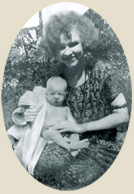 In
the early 1900s, the Hamner family moved from its James River
tobacco farm to the town of Schuyler -- named for its first
postmaster -- on the eastern slope of the Blue Ridge. Today
it is home to "The Gathering," a group of disciples
of the psychic Edgar Cayce. In the beginning, Schuyler was a
company town centered around the New Alberene Stone Company
which mined and milled soapstone. Earl Sr. worked there when
their first child, Earl Jr., was born on July 10, 1923.
In
the early 1900s, the Hamner family moved from its James River
tobacco farm to the town of Schuyler -- named for its first
postmaster -- on the eastern slope of the Blue Ridge. Today
it is home to "The Gathering," a group of disciples
of the psychic Edgar Cayce. In the beginning, Schuyler was a
company town centered around the New Alberene Stone Company
which mined and milled soapstone. Earl Sr. worked there when
their first child, Earl Jr., was born on July 10, 1923. 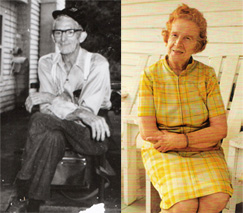 Money
was short, and books were a luxury they could not afford. Their
"library" consisted of the Holy Bible, (the King James
Version), and a manual of bee-keeping. Doris and Earl strongly
encouraged all the children in their growing family to excel,
and Earl Jr. became interested in writing at an early age. He
was writing his numbers at the age of two and reading at four.
His poem "My Dog" was published on the Children's
Page of the Richmond Times-Dispatch when
Money
was short, and books were a luxury they could not afford. Their
"library" consisted of the Holy Bible, (the King James
Version), and a manual of bee-keeping. Doris and Earl strongly
encouraged all the children in their growing family to excel,
and Earl Jr. became interested in writing at an early age. He
was writing his numbers at the age of two and reading at four.
His poem "My Dog" was published on the Children's
Page of the Richmond Times-Dispatch when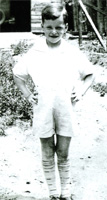 he was six. Earl claims he knew he was going to become a writer
from that day.
he was six. Earl claims he knew he was going to become a writer
from that day. 






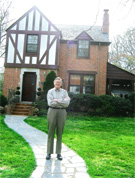 The
wife of the local doctor, Laura Horsley, became aware of Earl's
promise and was influential in his receiving a scholarship to
the University of Richmond. Attending the university was still
a financial challenge because the scholarship took care only
of tuition. Three of his father's sisters shared a home at 29
Willway Avenue in Richmond, Virginia. It was not a light undertaking,
but they were open to the idea of Earl Jr. coming to live with
them while he studied at the University of Richmond. Nora was
an executive with the American Lung Association. As a young
woman she had traveled the Blue Ridge back country as a nurse
on horseback. Lottie, a divorced mother, was an office manager,
and Margaret was a dietitian at Camp Merriwood Harrison, a summer
camp on the outskirts of Richmond for underprivileged children.
Their "colored girl," Sally Royal, and their mother,
Susan Henry Spencer Hamner, filled out the household.
The
wife of the local doctor, Laura Horsley, became aware of Earl's
promise and was influential in his receiving a scholarship to
the University of Richmond. Attending the university was still
a financial challenge because the scholarship took care only
of tuition. Three of his father's sisters shared a home at 29
Willway Avenue in Richmond, Virginia. It was not a light undertaking,
but they were open to the idea of Earl Jr. coming to live with
them while he studied at the University of Richmond. Nora was
an executive with the American Lung Association. As a young
woman she had traveled the Blue Ridge back country as a nurse
on horseback. Lottie, a divorced mother, was an office manager,
and Margaret was a dietitian at Camp Merriwood Harrison, a summer
camp on the outskirts of Richmond for underprivileged children.
Their "colored girl," Sally Royal, and their mother,
Susan Henry Spencer Hamner, filled out the household. 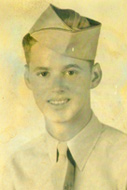 In
1943, in the middle of his sophomore year, Earl Hamner was drafted
into the U.S. Army. He trained initially at Fort Knox where
he almost learned to drive a Sherman Tank. He succeeded in getting
one so stuck in the mud that to this day no one has quite beat
his record. There he became friends with a fellow soldier, Paul
Nusnick, a Jewish man from Philadelphia, and one of the most
profound influences on his life. Nusnick hated the Army, but
loved American literature and introduced Hamner to a long list
of authors, including Thomas Wolfe, Sherwood Anderson, F. Scott
Fitzgerald, and William Faulkner. Hamner then spent several
months at the 19th Replacement Depot in England learning how
to diffuse land mines, one of the most dangerous of Army jobs.
Two months after D-day he landed on Omaha Beach, and, because
his officers had discovered that he knew how to type, he was
re-assigned to the 542nd Quartermaster Corps which he served
in Paris. He loved Paris, learned to speak French, and made
friends with the French people including a special girl named
Jeanine. It was here, after the end of the war, that he began
in earnest sending off stories for publication and amassing
rejection slips.
In
1943, in the middle of his sophomore year, Earl Hamner was drafted
into the U.S. Army. He trained initially at Fort Knox where
he almost learned to drive a Sherman Tank. He succeeded in getting
one so stuck in the mud that to this day no one has quite beat
his record. There he became friends with a fellow soldier, Paul
Nusnick, a Jewish man from Philadelphia, and one of the most
profound influences on his life. Nusnick hated the Army, but
loved American literature and introduced Hamner to a long list
of authors, including Thomas Wolfe, Sherwood Anderson, F. Scott
Fitzgerald, and William Faulkner. Hamner then spent several
months at the 19th Replacement Depot in England learning how
to diffuse land mines, one of the most dangerous of Army jobs.
Two months after D-day he landed on Omaha Beach, and, because
his officers had discovered that he knew how to type, he was
re-assigned to the 542nd Quartermaster Corps which he served
in Paris. He loved Paris, learned to speak French, and made
friends with the French people including a special girl named
Jeanine. It was here, after the end of the war, that he began
in earnest sending off stories for publication and amassing
rejection slips. 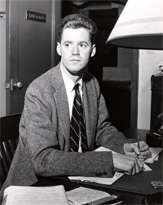 From
Arkansas, Hamner went back to Virginia for the wedding of his
sister, Marion, to Glen Hawkes. After the wedding he hitched
a ride up to New York City where he found a temporary Christmas
sales job at Macy's. Soon he was hired as a radio writer by
the NBC network.
From
Arkansas, Hamner went back to Virginia for the wedding of his
sister, Marion, to Glen Hawkes. After the wedding he hitched
a ride up to New York City where he found a temporary Christmas
sales job at Macy's. Soon he was hired as a radio writer by
the NBC network. 


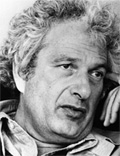 on
the "Purgatory" boat. Next door lived a man who Hamner
describes as a "tall, impressive, sharp-tongued guy"
who worked at the ad department of Time/Life. He confessed he
was working on what he would only divulge as a "little
comedy." In 1961, Joseph Heller published his "little
comedy" which turned out to be Catch-22!
on
the "Purgatory" boat. Next door lived a man who Hamner
describes as a "tall, impressive, sharp-tongued guy"
who worked at the ad department of Time/Life. He confessed he
was working on what he would only divulge as a "little
comedy." In 1961, Joseph Heller published his "little
comedy" which turned out to be Catch-22!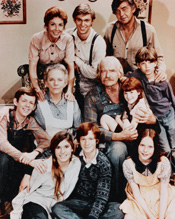 In
1970, The Homecoming was published by Random House. It
became a CBS Christmas television special, and then in 1972,
the basis for the long-running series, The Waltons. The
first year it received five Emmys, and it ran for nine years.
As the
In
1970, The Homecoming was published by Random House. It
became a CBS Christmas television special, and then in 1972,
the basis for the long-running series, The Waltons. The
first year it received five Emmys, and it ran for nine years.
As the 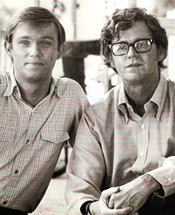 producer
and creator of the series, Hamner had other writers working
under him. He describes his role as sometimes more of a re-writer
than a writer, but points out that this position allowed him
to attempt to provide a depth of character for his actors that
is seldom achieved in television. Hamner loves to tell stories
about his interactions with actors. He told Alex Paige:
producer
and creator of the series, Hamner had other writers working
under him. He describes his role as sometimes more of a re-writer
than a writer, but points out that this position allowed him
to attempt to provide a depth of character for his actors that
is seldom achieved in television. Hamner loves to tell stories
about his interactions with actors. He told Alex Paige:  way over to the doorway, and looked back at me and said, 'You
son of a bitch!' (laughs) I mean, this was this nice old lady,
Grandma -- so we got over that anyway; we really were fond of
each other. When she died, Michael Learned called me and said,
'We're putting Ellen's ashes in the mausoleum today. Would you
like to come?' I said, 'of course,' and so I thought, I should
take something. Flowers. Then I thought, Ellen would hate flowers!
And so I sat down and I wrote a beautiful scene which Ellen
as Grandma dominated. It was put in the vault with her ashes."
way over to the doorway, and looked back at me and said, 'You
son of a bitch!' (laughs) I mean, this was this nice old lady,
Grandma -- so we got over that anyway; we really were fond of
each other. When she died, Michael Learned called me and said,
'We're putting Ellen's ashes in the mausoleum today. Would you
like to come?' I said, 'of course,' and so I thought, I should
take something. Flowers. Then I thought, Ellen would hate flowers!
And so I sat down and I wrote a beautiful scene which Ellen
as Grandma dominated. It was put in the vault with her ashes."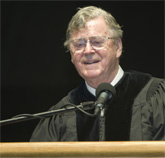 But,
as he told students at the University of Cincinnati in 2004,
But,
as he told students at the University of Cincinnati in 2004, Today,
Earl Hamner still writes every day and is still involved in
television, although he claims that on his visits to the networks
they offer him a glass of warm milk and help him to his seat!
If anything, he has stepped up his book writing. Goodnight
John-Boy (2002), The Twilight Zone
Today,
Earl Hamner still writes every day and is still involved in
television, although he claims that on his visits to the networks
they offer him a glass of warm milk and help him to his seat!
If anything, he has stepped up his book writing. Goodnight
John-Boy (2002), The Twilight Zone  Scripts
of Earl Hamner (2003), and Generous Women (2006)
have ensued. However, he also feels free to fly-cast for bone
fish in Florida, troll for salmon in British Columbia, and seek
marlin in Baja. At home he has 50 Bonsai trees to tend, and
he and his wife have a Pug named Peaches who adores Jane and
tolerates Earl. At the moment he is adapting Spencer's Mountain
into a stage play to be performed at the Earl Hamner Theater
and also completing a book of short stories.
Scripts
of Earl Hamner (2003), and Generous Women (2006)
have ensued. However, he also feels free to fly-cast for bone
fish in Florida, troll for salmon in British Columbia, and seek
marlin in Baja. At home he has 50 Bonsai trees to tend, and
he and his wife have a Pug named Peaches who adores Jane and
tolerates Earl. At the moment he is adapting Spencer's Mountain
into a stage play to be performed at the Earl Hamner Theater
and also completing a book of short stories.